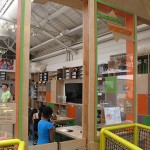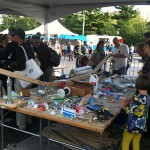- ‘Makeshop’ at the Children’s Museum of Pittsburgh
- ‘Imagination Workshop’ Pasadena Children’s Museum
- World Maker Faire 2012 at NY Hall of Science
Defined as individuals or groups using discarded or broken materials to create something new, the Maker Movement first emerged into mainstream culture through Maker Faire, an event created by Make magazine to “celebrate arts, crafts, engineering, science projects and the Do-It-Yourself Mindset”. Since the first Maker Faire in 2006, the movement has grown beyond a single annual festival to include membership-based maker spaces and labs all over the country, that encourage members to create, innovate, and think outside of the box. The results really quite amazing.
Many makers’ innovations take the form of new technology in the areas of robotics, engineering, and electronics. Other creations center around more traditional forms like sewing, wood-working, metal-working, and art. With the growing popularity of DIY culture, it’s no surprise that we’ve started sharing the fun with our kids. The Maker Movement has expanded beyond the adult audience into children’s museums, art centers, and even the classroom at school. Kids are itching for hands-on activities that take them beyond the screen. Just like their parents, they want to “do it themselves” and the learning-through-doing environment of a hackerspace or fab lab is the perfect place for kids to assert their creativity and maybe even get a little dirty.
In addition to kids and parents, the Maker Movement has attracted the attention of educators who desire to engage students in a non-traditional approach to STEAM subjects. Through hands-on problem solving, educators are able to give students the opportunity to see science, technology, engineering, art, and math in action. Infusing elements of the Maker Movement into museum and classroom activities brings subject matter to life. A problem is no longer just words on a page – it becomes something that students can interact with, giving them greater ownership of the problem as well as the steps they take to determine a solution.
For the next few weeks, we will hear from industry professionals on how they have engaged with the Maker Movement, what they’ve learned, and how we can infuse our curriculum with more opportunities for creativity and innovation.


